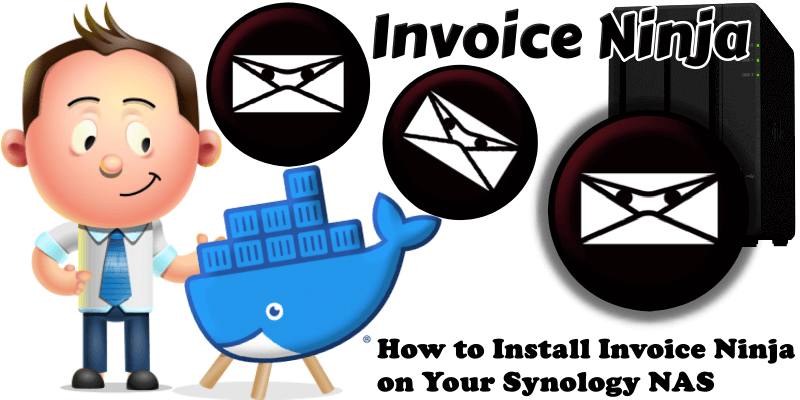
Invoice Ninja is a leading platform for freelancers & SMB’s to invoice clients, accept payments, track expenses & time-billable tasks. Invoicing, Quotes, Expenses, Tasks. Built with Laravel, Flutter and React. In this step by step guide I will show you how to install Invoice Ninja on your Synology NAS using Docker & Portainer.
STEP 1
Please Support My work by Making a Donation.
STEP 2
Install Portainer using my step by step guide. If you already have Portainer installed on your Synology NAS, skip this STEP. Attention: Make sure you have installed the latest Portainer version.
STEP 3
Make sure you have a synology.me Wildcard Certificate. Follow my guide to get a Wildcard Certificate. If you already have a synology.me Wildcard certificate, skip this STEP.
STEP 4
Go to Control Panel / Login Portal / Advanced Tab / click Reverse Proxy. Follow the instructions in the image below.
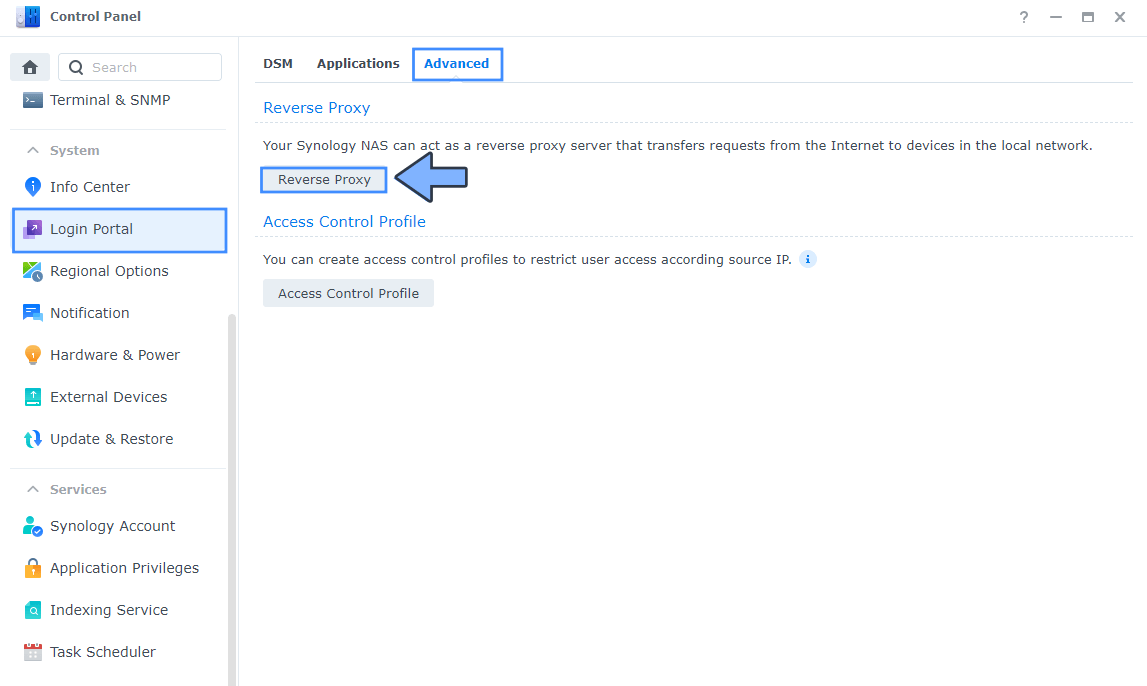
STEP 5
Now click the “Create” button. Follow the instructions in the image below.
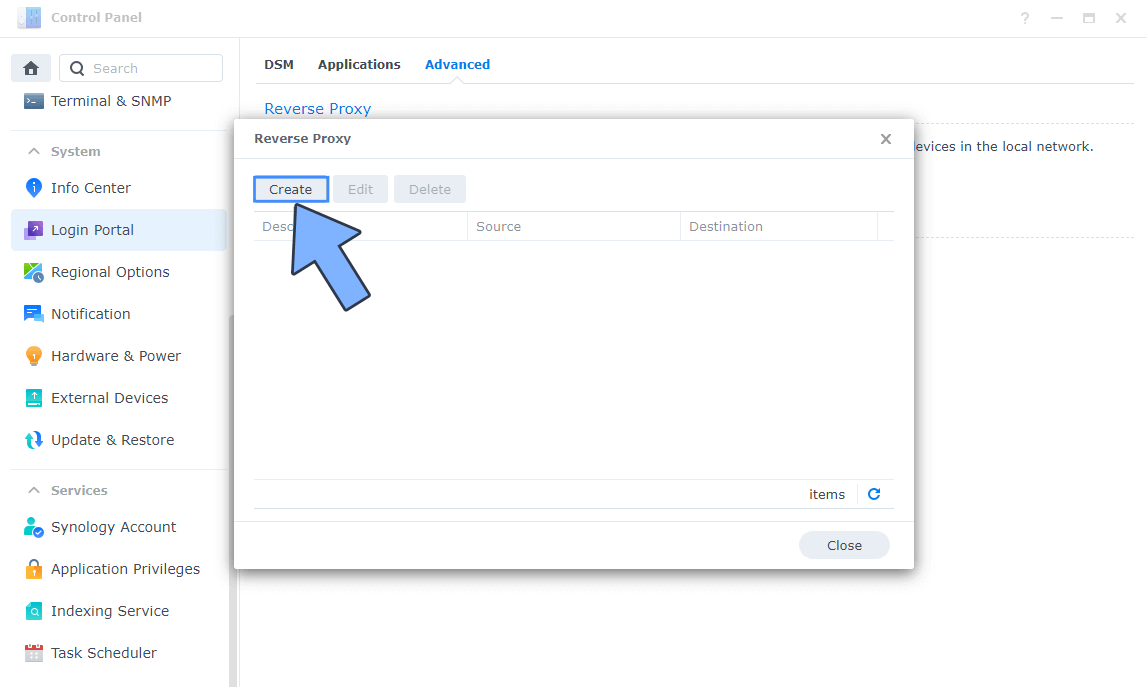
STEP 6
After you click the Create button, the window below will open. Follow the instructions in the image below.
On the General area, set the Reverse Proxy Name description: type in Invoice Ninja. After that, add the following instructions:
Source:
Protocol: HTTPS
Hostname: invoiceninja.yourname.synology.me
Port: 443
Check Enable HSTS
Destination:
Protocol: HTTP
Hostname: localhost
Port: 5485
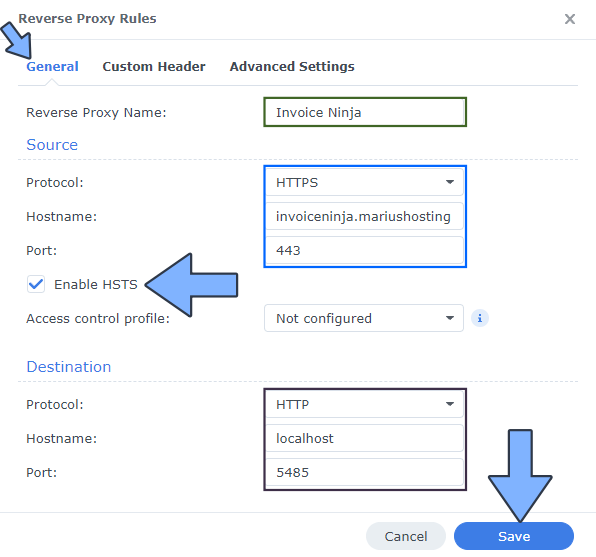
STEP 7
On the Reverse Proxy Rules click the Custom Header tab. Click Create and then, from the drop-down menu, click WebSocket. After you click on WebSocket, two Header Names and two Values will be automatically added. Click Save. Follow the instructions in the image below.

STEP 8
Go to Control Panel / Network / Connectivity tab/ Check Enable HTTP/2 then click Apply. Follow the instructions in the image below.

STEP 9
Go to Control Panel / Security / Advanced tab/ Check Enable HTTP Compression then click Apply. Follow the instructions in the image below.
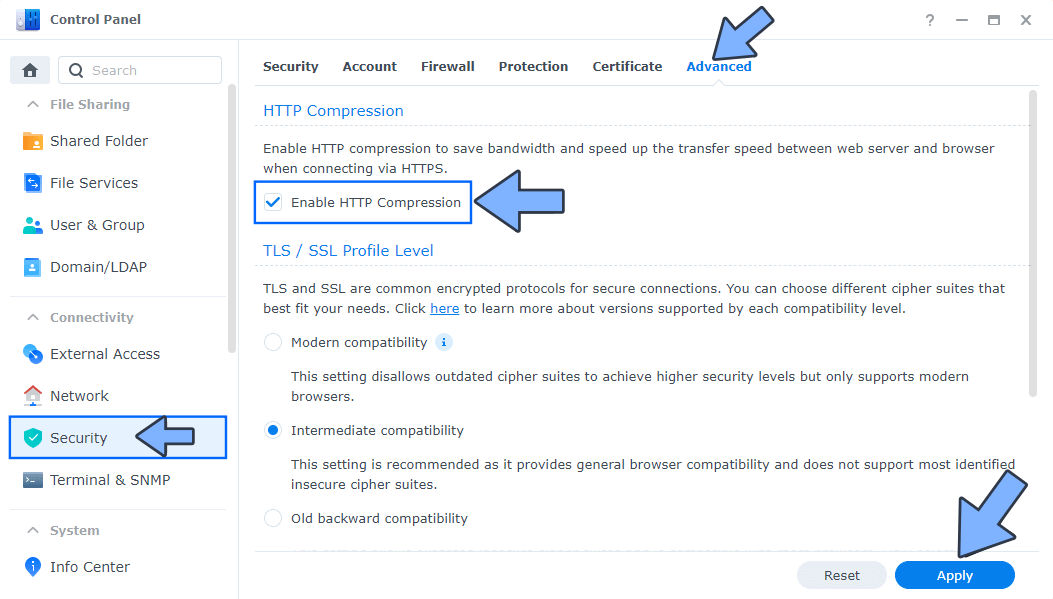
STEP 10
Go to File Station and open the docker folder. Inside the docker folder, create one new folder and name it invoiceninja. Follow the instructions in the image below.
Note: Be careful to enter only lowercase, not uppercase letters.
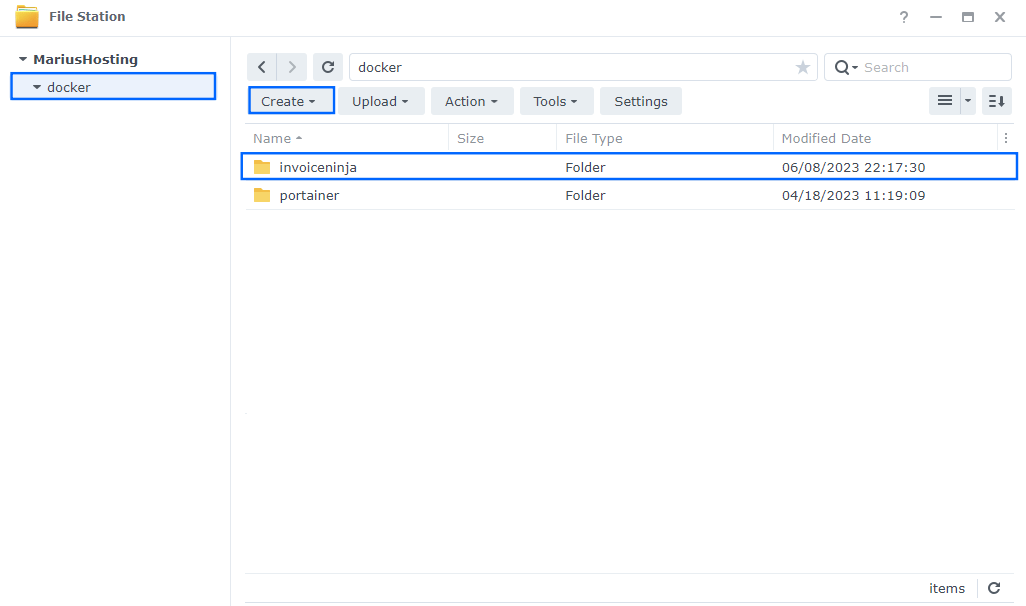
STEP 11
Now create four new folders inside the invoiceninja folder that you created at STEP 10 and name them db, public, redis, storage. Follow the instructions in the image below.
Note: Be careful to enter only lowercase, not uppercase letters.
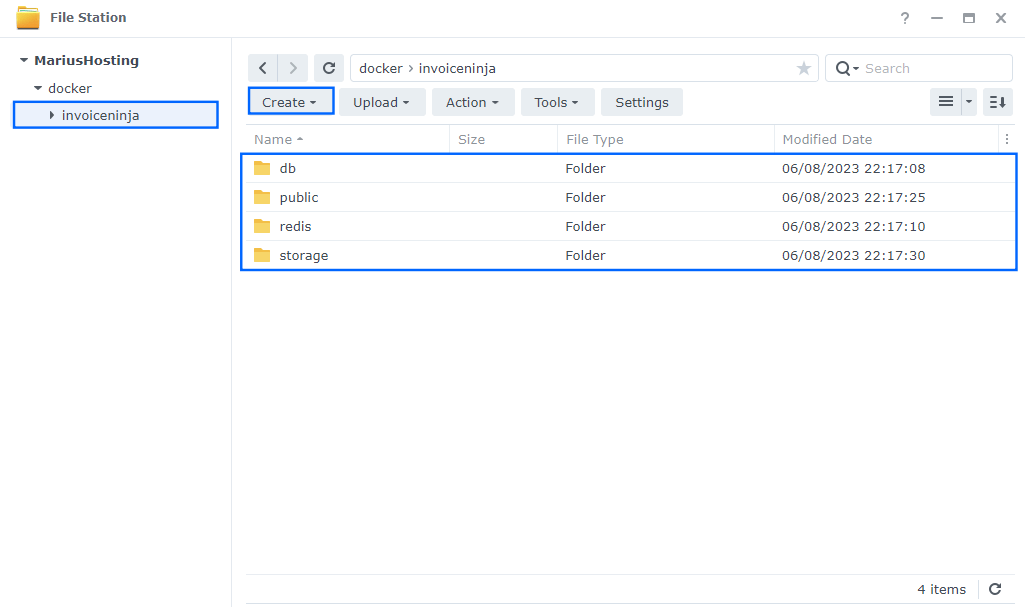
STEP 12
Download (click on the blue link below) then upload the in-vhost.conf file below in the invoiceninja folder that you have previously created at STEP 10. Follow the instructions in the image below. 🔒Note: Support my work to unlock the password. You can use this password to download any file on mariushosting forever!

STEP 13
Right click on the invoiceninja folder that you have previously created at STEP 10 then click Properties. Follow the instructions in the image below.
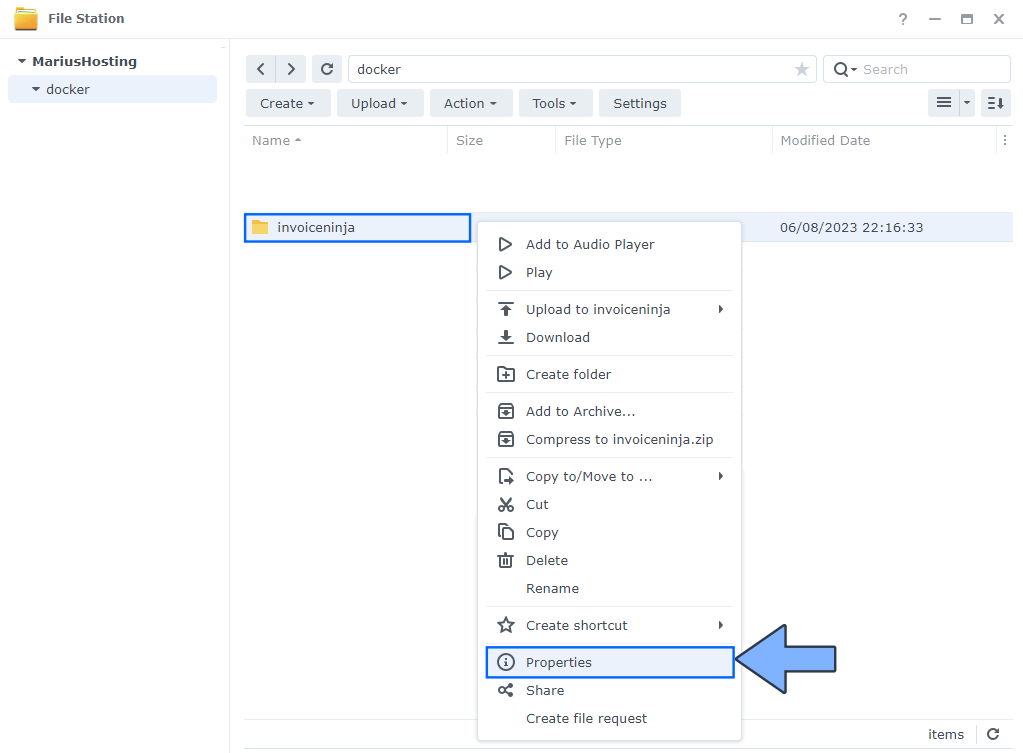
STEP 14
Go to the Permission tab then click Advanced options. From the drop-down menu choose “Make inherited permissions explicit“. Follow the instructions in the image below.

STEP 15
Select Everyone then click the Edit tab. Follow the instructions in the image below.

STEP 16
Check all Read and Write Permissions. Click Done. Follow the instructions in the image below.
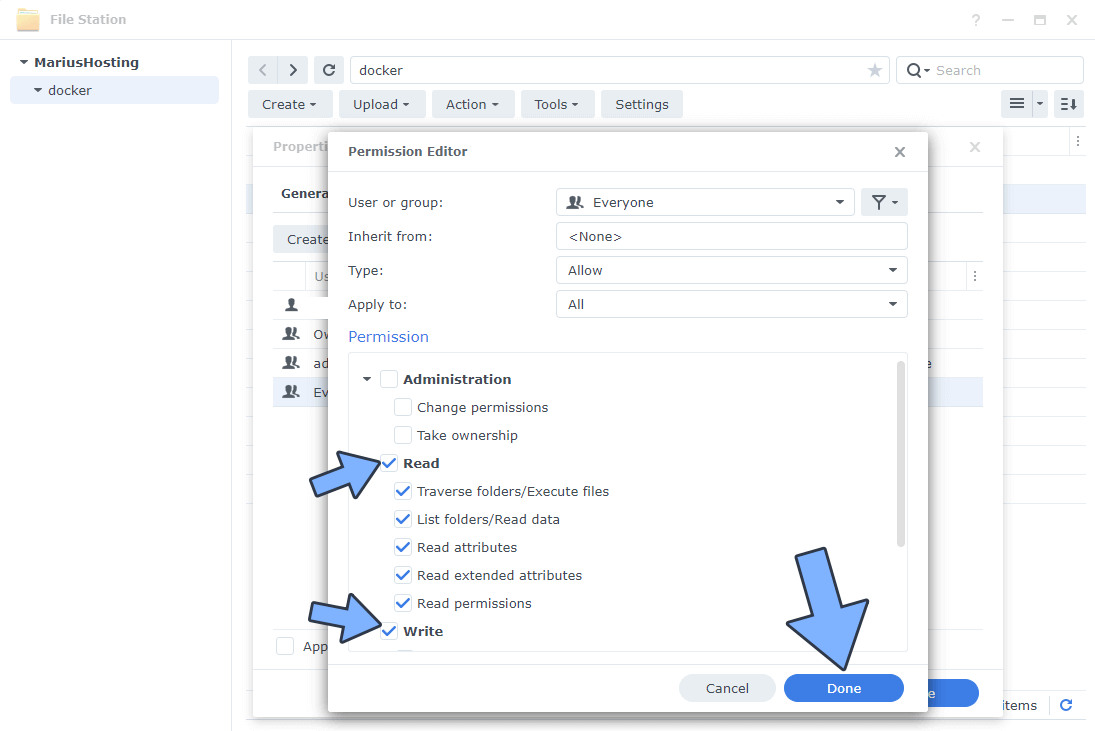
STEP 17
After you click Done on STEP 16, check “Apply to this folder, sub-folders and files“. Click Save. Follow the instructions in the image below.
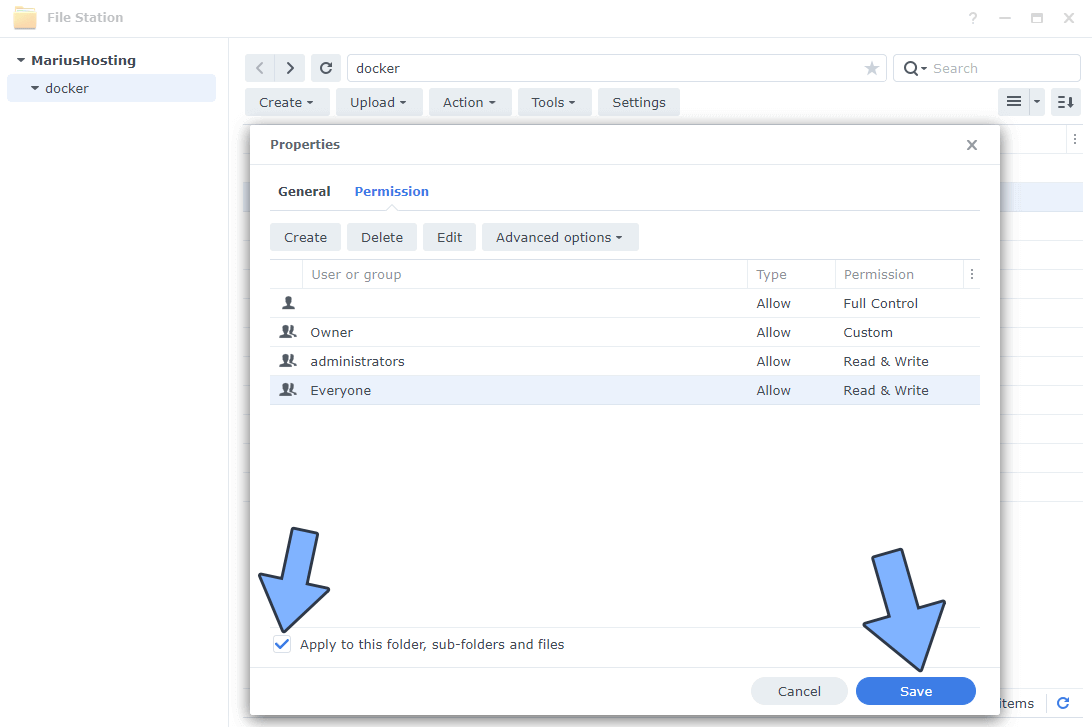
STEP 18
Follow my step by step guide on how to activate SMTP for your Gmail account. This step is mandatory. Note: If you don’t want to use the easiest way for SMTP with Google and you already have SMTP details from your own Mail Server, you can just skip this STEP and use your personalized email SMTP details instead.
STEP 19
Log into Portainer using your username and password. On the left sidebar in Portainer, click on Home then Live connect. Follow the instructions in the image below.

On the left sidebar in Portainer, click on Stacks then + Add stack. Follow the instructions in the image below.

STEP 20
In the Name field type in invoiceninja. Follow the instructions in the image below.
services:
redis:
image: redis
command:
- /bin/sh
- -c
- redis-server --requirepass redispass
container_name: InvoiceNinja-REDIS
hostname: invoiceninja-redis
mem_limit: 256m
mem_reservation: 50m
cpu_shares: 768
security_opt:
- no-new-privileges:true
read_only: true
user: 1026:100
healthcheck:
test: ["CMD-SHELL", "redis-cli ping || exit 1"]
volumes:
- /volume1/docker/invoiceninja/redis:/data:rw
environment:
TZ: Europe/Bucharest
restart: on-failure:5
db:
image: mariadb:11.4-noble #LTS Long Time Support Until May 29, 2029.
container_name: InvoiceNinja-DB
hostname: invoiceninja-db
mem_limit: 1g
cpu_shares: 768
security_opt:
- no-new-privileges:false
- seccomp:unconfined
- apparmor:unconfined
volumes:
- /volume1/docker/invoiceninja/db:/var/lib/mysql:rw
environment:
TZ: Europe/Bucharest
MYSQL_ROOT_PASSWORD: rootpass
MYSQL_DATABASE: invoiceninja
MYSQL_USER: ninjauser
MYSQL_PASSWORD: ninjapass
restart: on-failure:5
invoiceninja:
image: invoiceninja/invoiceninja:latest
container_name: InvoiceNinja
hostname: invoiceninja
mem_limit: 4g
cpu_shares: 768
security_opt:
- no-new-privileges:true
healthcheck:
test: stat /etc/passwd || exit 1
volumes:
- /volume1/docker/invoiceninja/public:/var/www/app/public:rw
- /volume1/docker/invoiceninja/storage:/var/www/app/storage:rw
environment:
APP_NAME: Invoice Ninja
APP_ENV: production
APP_KEY: base64:nQhdYqmk7FNh9S/OMpWO/y3SDOkD1XxvvRMltw6kSJU=
APP_DEBUG: false
APP_URL: https://invoiceninja.yourname.synology.me
IN_USER_EMAIL: yourown@email
IN_PASSWORD: mariushosting
REQUIRE_HTTPS: true
TRUSTED_PROXIES: "*"
IS_DOCKER: true
QUEUE_CONNECTION: database
DB_HOST: invoiceninja-db
DB_DATABASE: invoiceninja
DB_USERNAME: ninjauser
DB_PASSWORD: ninjapass
CACHE_DRIVER: redis
SESSION_DRIVER: redis
REDIS_HOST: invoiceninja-redis
REDIS_PASSWORD: redispass
# PHANTOMJS_KEY='a-demo-key-with-low-quota-per-ip-address'
# PHANTOMJS_SECRET=password
PHANTOMJS_PDF_GENERATION: false
PDF_GENERATOR: snappdf
MAIL_MAILER: smtp
MAIL_HOST: smtp.gmail.com
MAIL_PORT: 587
MAIL_USERNAME: Your-own-gmail-address
MAIL_PASSWORD: Your-own-app-password
MAIL_ENCRYPTION: STARTTLS
MAIL_FROM_ADDRESS: Your-own-gmail-address
MAIL_FROM_NAME: Invoice
#ERROR_EMAIL: error@mail.com # Error emails are sent to this email
restart: on-failure:5
depends_on:
redis:
condition: service_healthy
db:
condition: service_started
nginx:
image: nginx:latest
container_name: InvoiceNinja-NGINX
hostname: invoiceninja-nginx
mem_limit: 512m
cpu_shares: 768
security_opt:
- no-new-privileges:true
healthcheck:
test: curl -f http://localhost:80/ || exit 1
ports:
- 5485:80
volumes:
- /volume1/docker/invoiceninja/in-vhost.conf:/etc/nginx/conf.d/in-vhost.conf:ro
- /volume1/docker/invoiceninja/public:/var/www/app/public:ro
restart: on-failure:5
depends_on:
invoiceninja:
condition: service_started
Note: Before you paste the code above in the Web editor area below, change the value numbers for user with your own UID and GID values. (Follow my step by step guide on how to do this.) 1026 is my personal UID value and 100 is my personal GID value. You have to type in your own values.
Note: Before you paste the code above in the Web editor area below, change the value for TZ. (Select your current Time Zone from this list.)
Note: Before you paste the code above in the Web editor area below, change the value for APP_KEY. (Generate your own free APP KEY.)
Note: Before you paste the code above in the Web editor area below, change the value for APP_URL and type in your own synology.me DDNS with https:// at the beginning that you have previously created at STEP 6.
Note: Before you paste the code above in the Web editor area below, change the value for IN_USER_EMAIL and type in your own administrator email address. You will need this email at STEP 24.
Note: Before you paste the code above in the Web editor area below, change the value for IN_PASSWORD and type in your own administrator password. mariushosting is an example for a password. You should type in your own password. You will need this password at STEP 24.
Note: Before you paste the code above in the Web editor area below, change the value for MAIL_USERNAME and type in your own Gmail address. STEP 18.
Note: Before you paste the code above in the Web editor area below, change the value for MAIL_PASSWORD and type in your own Gmail app password. STEP 18.
Note: Before you paste the code above in the Web editor area below, change the value for MAIL_FROM_ADDRESS and type in your own Gmail address. STEP 18.
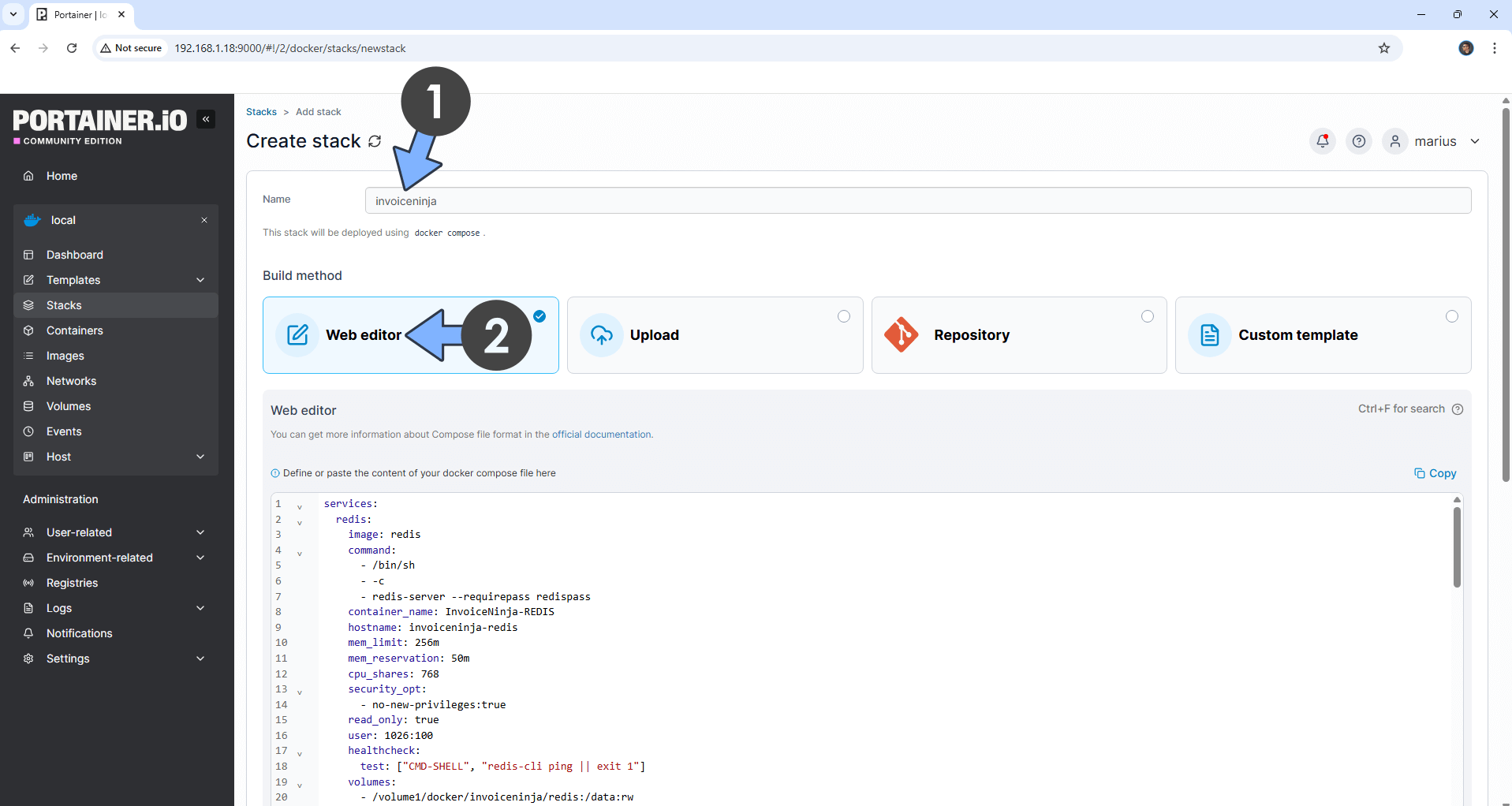
STEP 21
Scroll down on the page until you see a button named Deploy the stack. Click on it. Follow the instructions in the image below. The installation process can take up to a few minutes. It will depend on your Internet speed connection.
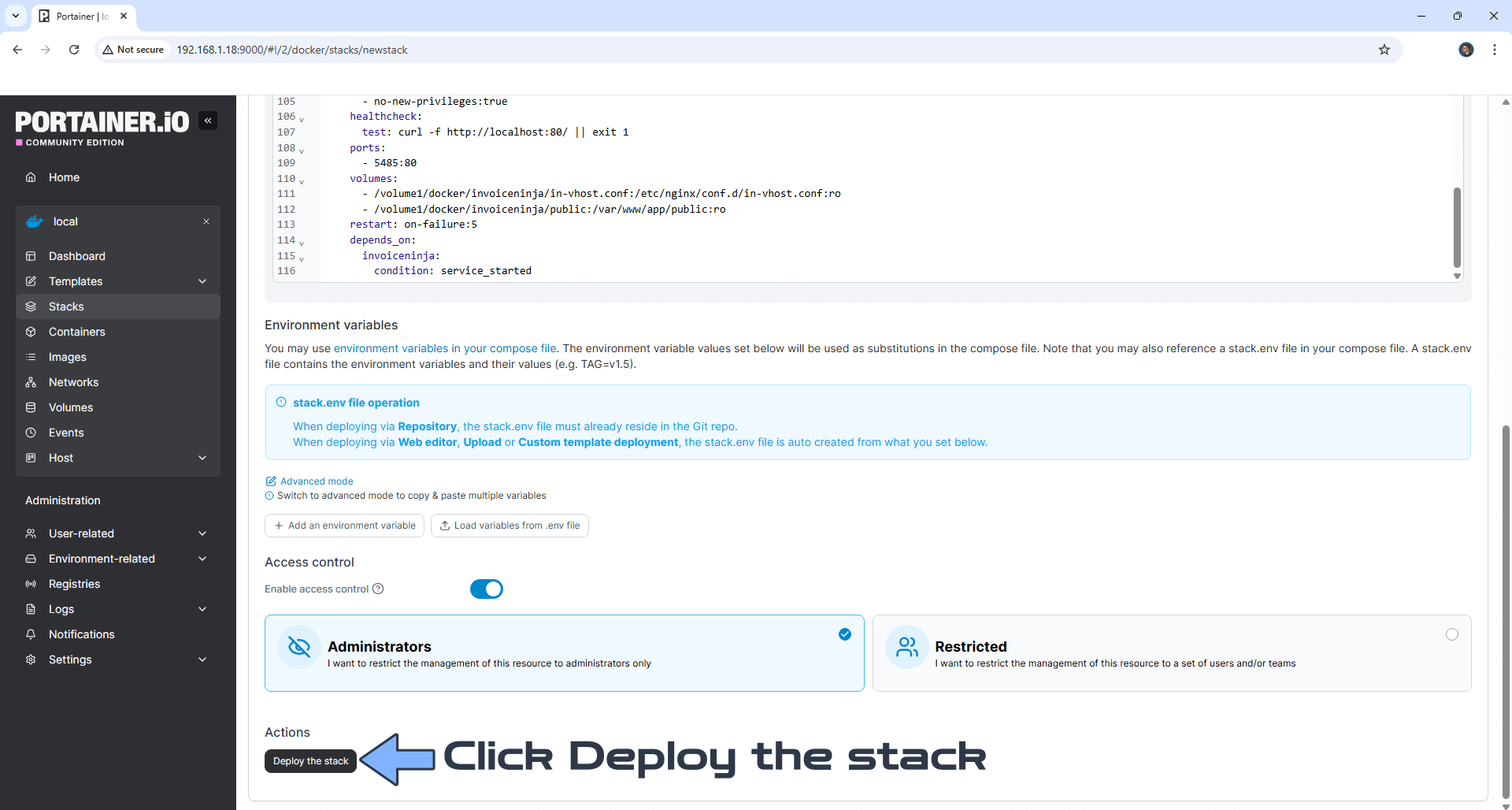
STEP 22
If everything goes right, you will see the following message at the top right of your screen: “Success Stack successfully deployed“.

STEP 23
🟢Please Support My work by Making a Donation. Almost 99,9% of the people that install something using my guides forget to support my work, or just ignore STEP 1. I’ve been very honest about this aspect of my work since the beginning: I don’t run any ADS, I don’t require subscriptions, paid or otherwise, I don’t collect IPs, emails, and I don’t have any referral links from Amazon or other merchants. I also don’t have any POP-UPs or COOKIES. I have repeatedly been told over the years how much I have contributed to the community. It’s something I love doing and have been honest about my passion since the beginning. But I also Need The Community to Support me Back to be able to continue doing this work.
STEP 24
Please wait approximately 3-5 minutes for the installation to be completed or you will get a 502 bad gateway page. Now open your browser and type in your HTTPS/SSL certificate like this https://invoiceninja.yourname.synology.me that you have previously created at STEP 6. In my case it’s https://invoiceninja.mariushosting.synology.me If everything goes right, you will see the Invoice Ninja login page. Type in your own Email (IN_USER_EMAIL) and Password (IN_PASSWORD) that you have previously created at STEP 20 then click Login with email. Follow the instructions in the image below.
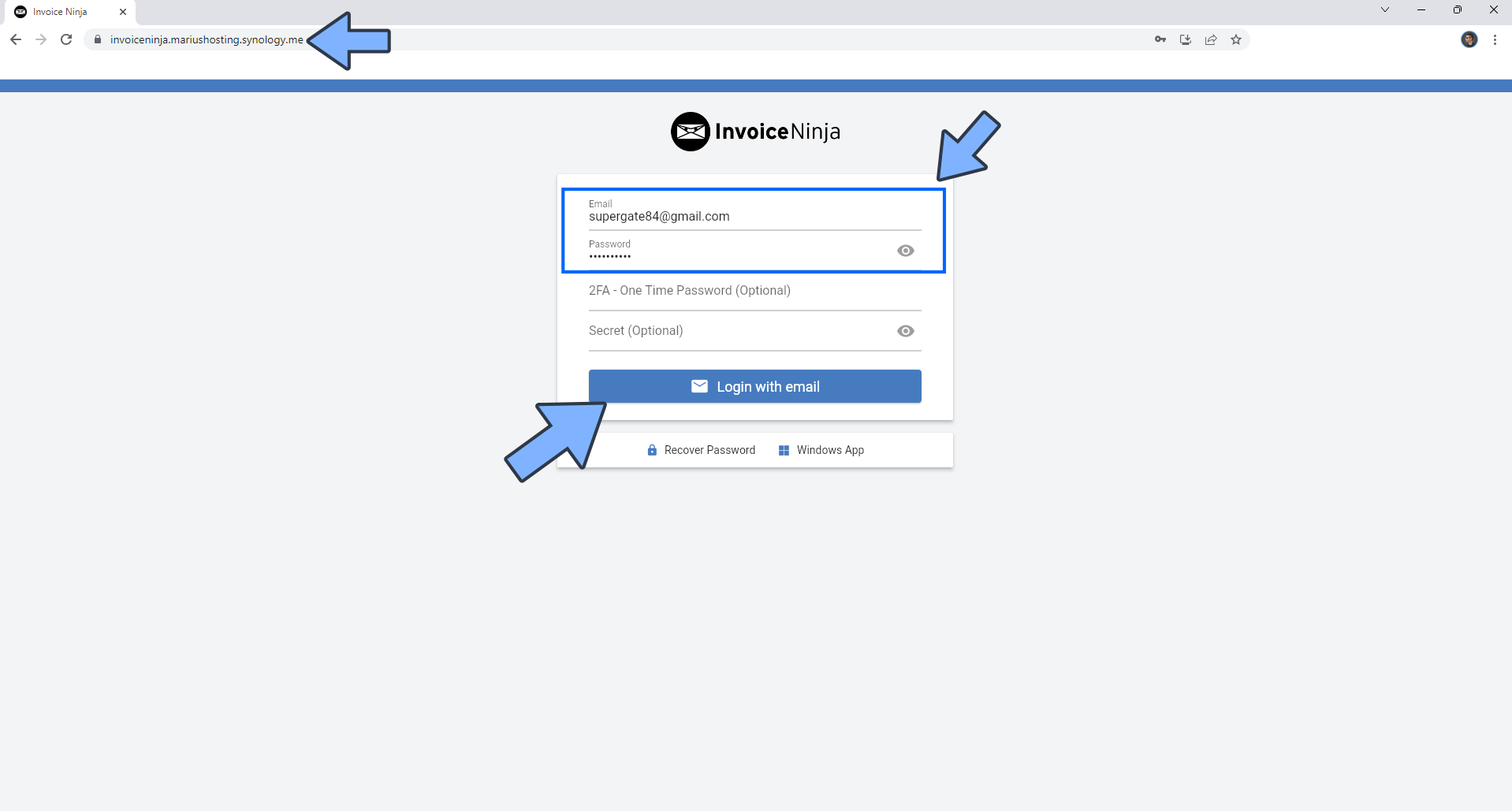
STEP 25
Set up your Company Name, First Name, Last Name, Language, Currency and the theme you want. Click Save. Follow the instructions in the image below.
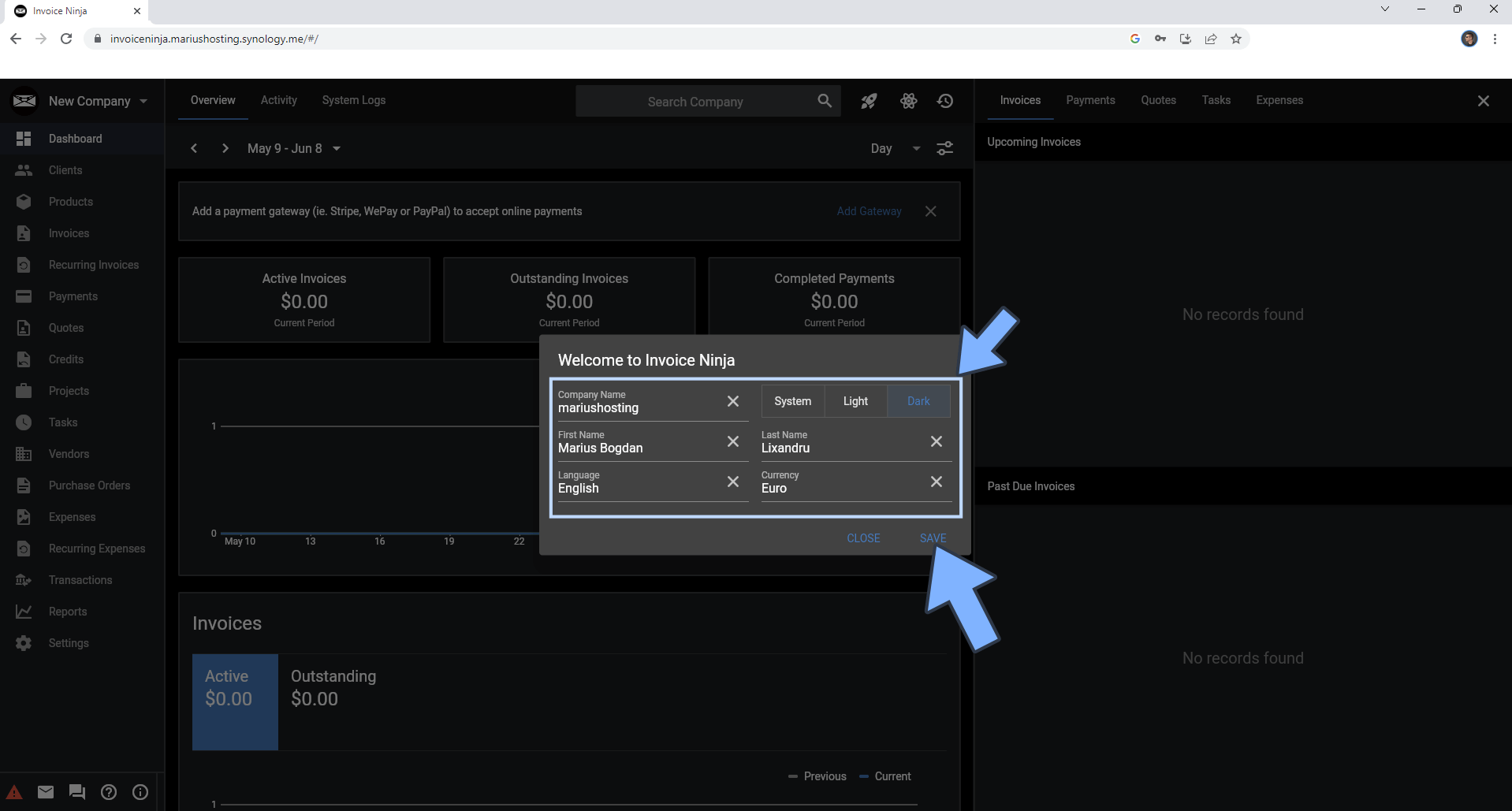
STEP 26
You will be asked to upload your own logo. Click UPLOAD. Follow the instructions in the image below.
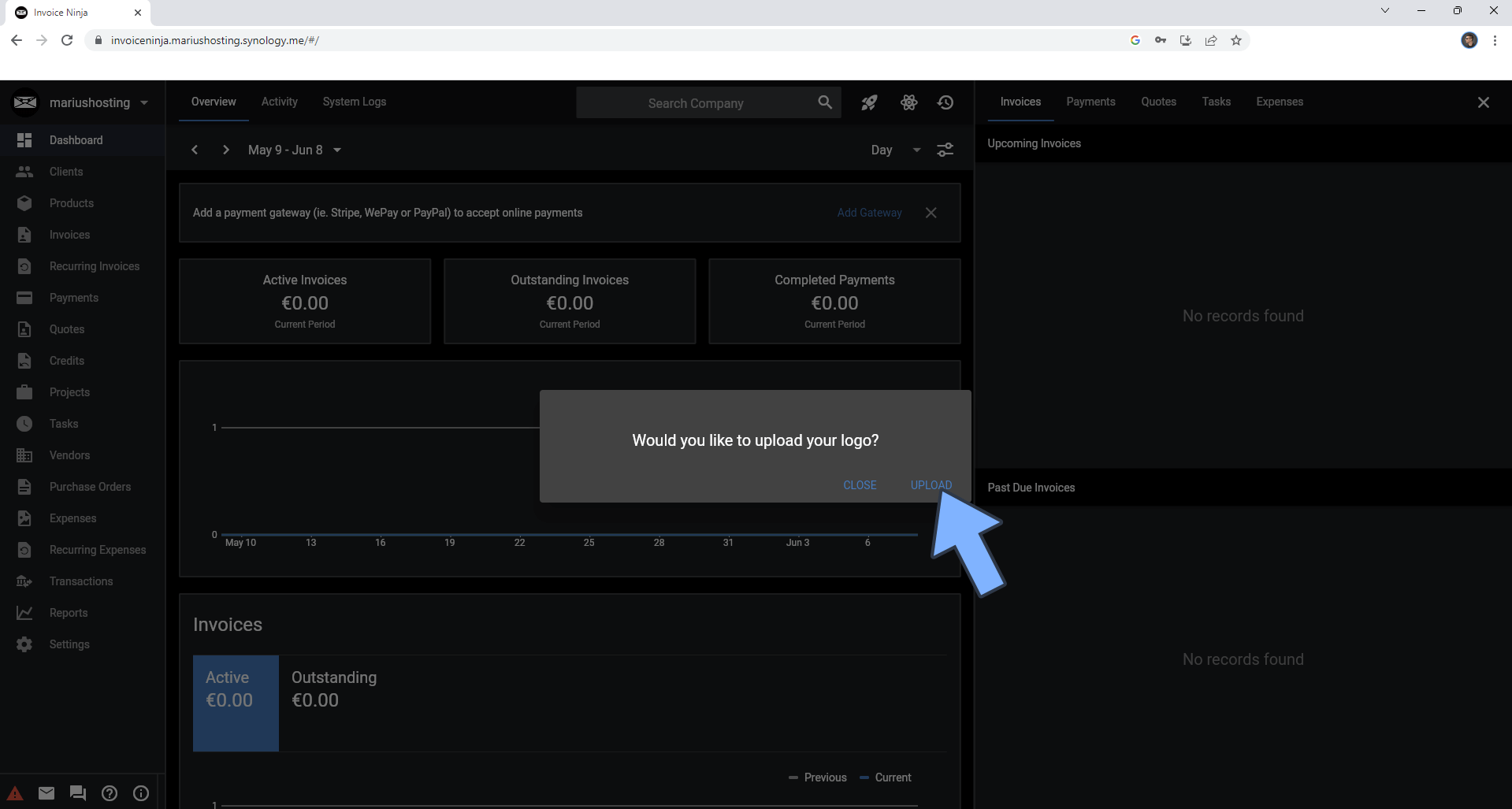
STEP 27
After you upload your own logo, click Save at the top right of the page. Follow the instructions in the image below.
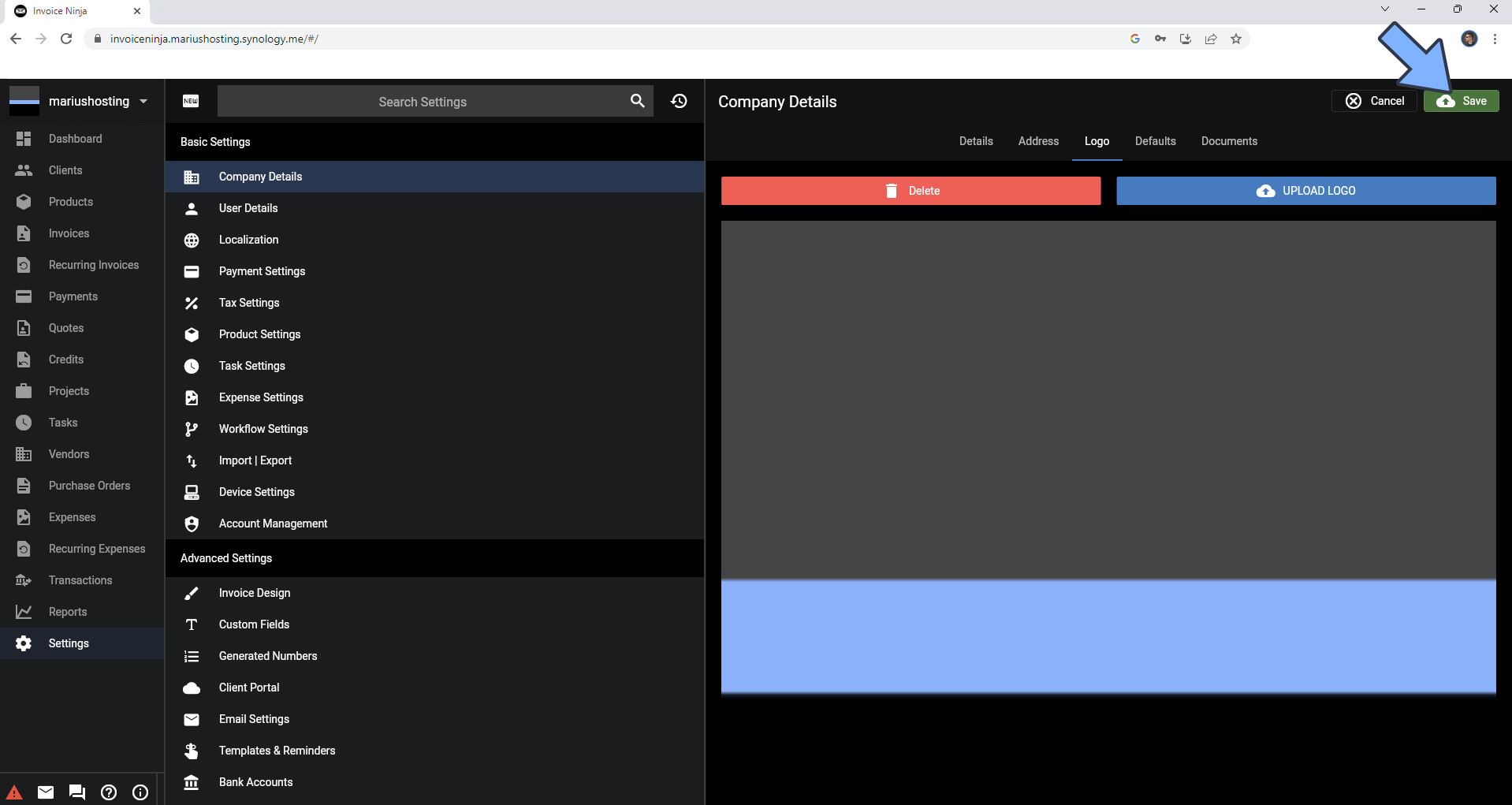
STEP 28
Invoice Ninja dashboard at a glance!
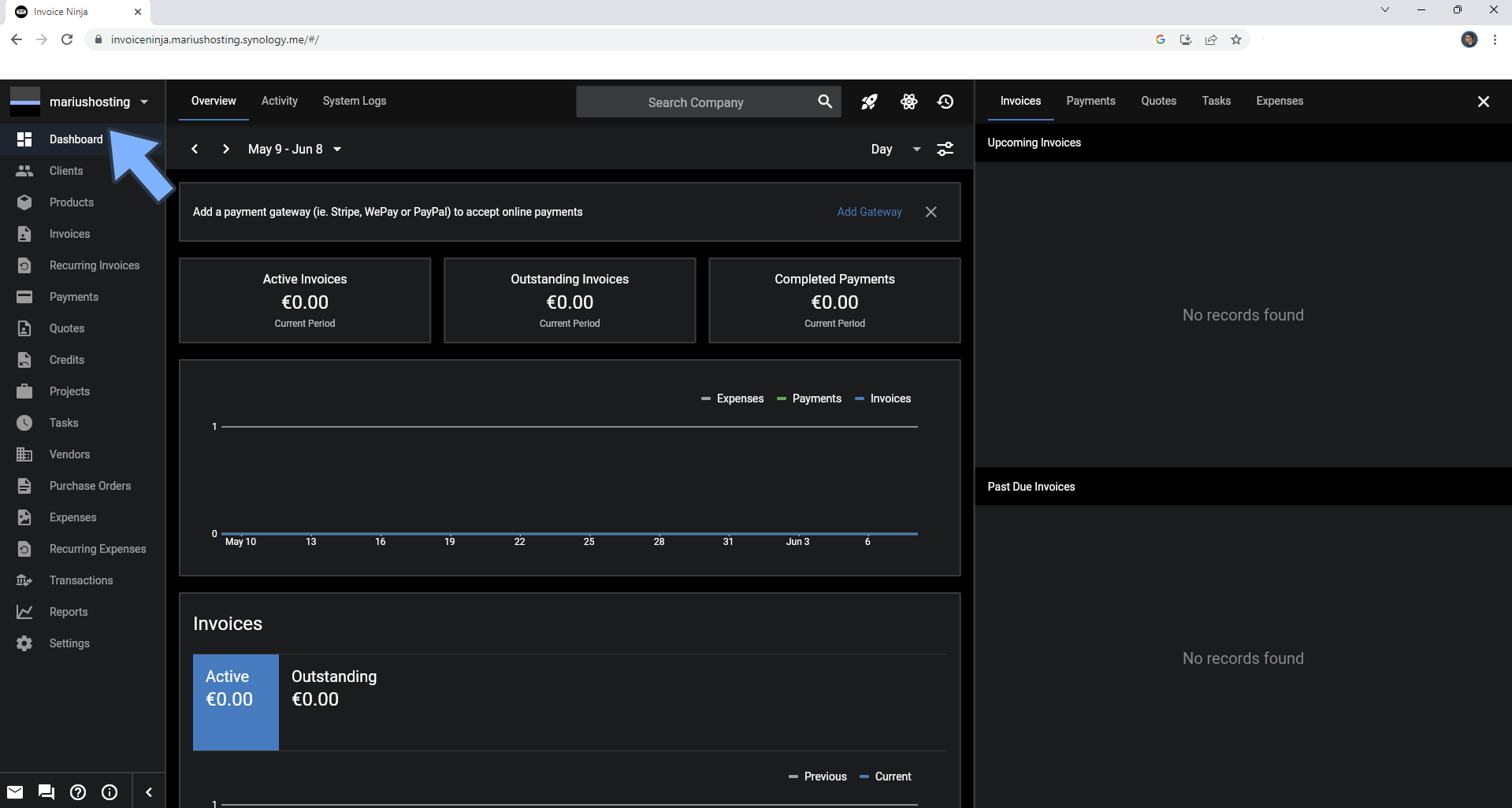
STEP 29
Start creating your first invoice!
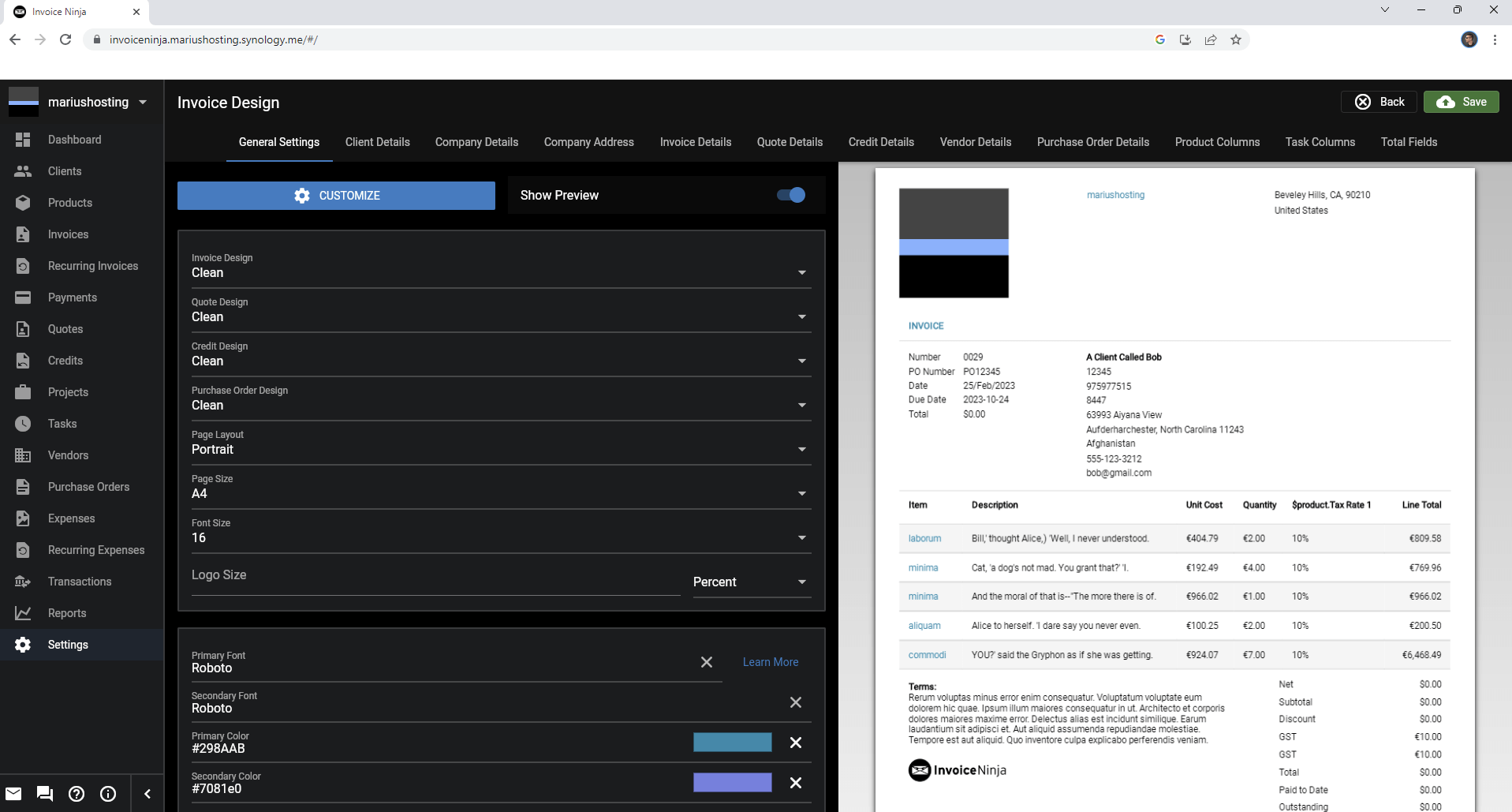
Enjoy Invoice Ninja!
If you encounter issues by using this container, make sure to check out the Common Docker issues article.
Note: Can I run Docker on my Synology NAS? See the supported models.
Note: How to Back Up Docker Containers on your Synology NAS.
Note: Find out how to update the Invoice Ninja container with the latest image.
Note: How to Free Disk Space on Your NAS if You Run Docker.
Note: How to Schedule Start & Stop For Docker Containers.
Note: How to Activate Email Notifications.
Note: How to Add Access Control Profile on Your NAS.
Note: How to Change Docker Containers Restart Policy.
Note: How to Use Docker Containers With VPN.
Note: Convert Docker Run Into Docker Compose.
Note: How to Clean Docker.
Note: How to Clean Docker Automatically.
Note: Best Practices When Using Docker and DDNS.
Note: Some Docker Containers Need WebSocket.
Note: Find out the Best NAS Models For Docker.
Note: Activate Gmail SMTP For Docker Containers.
This post was updated on Saturday / December 20th, 2025 at 12:47 AM
